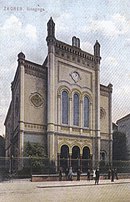Portal:Judaism
The Judaism PortalJudaism (Hebrew: יַהֲדוּת Yahăḏūṯ) is an Abrahamic, monotheistic, and ethnic religion, comprises the collective spiritual, cultural, and legal traditions of the Jewish people. Contemporary Judaism having originated as an organized religion in the Middle East during the Bronze Age, and evolved from Yahwism, the cultic religious movement of ancient Israel and Judah, around the 6th/5th century BCE, and is thus considered to be one of the oldest monotheistic religions.[improper synthesis?] Along with Samaritanism, to which it is closely related, Judaism is one of the two oldest Abrahamic religions. Religious Jews regard Judaism as their means of observing the Mosaic covenant, which was established between God and the Israelites, their ancestors. Jewish religious doctrine encompasses a wide body of texts, practices, theological positions, and forms of organization. Among Judaism's core texts is the Torah, the first five books of the Hebrew Bible, a collection of ancient Hebrew scriptures. The Tanakh, known in English as the Hebrew Bible, is also referred to as the "Old Testament" in Christianity. In addition to the original written scripture, the supplemental Oral Torah is represented by later texts, such as the Midrash and the Talmud. The Hebrew-language word torah can mean "teaching", "law", or "instruction", although "Torah" can also be used as a general term that refers to any Jewish text that expands or elaborates on the original Five Books of Moses. Representing the core of the Jewish spiritual and religious tradition, the Torah is a term and a set of teachings that are explicitly self-positioned as encompassing at least seventy, and potentially infinite, facets and interpretations. Judaism's texts, traditions, and values strongly influenced later Abrahamic religions, including Christianity and Islam. Hebraism, like Hellenism, played a seminal role in the formation of Western civilization through its impact as a core background element of Early Christianity. (Full article...) Selected ArticleThe Western Wall is located in the Old City of Jerusalem at the foot of the western side of the Temple Mount. It is a remnant of the ancient wall that surrounded the Jewish Temple's courtyard, and is perhaps the most sacred site recognized by the Jewish faith outside of the Temple Mount itself. Just over half the wall, including its 17 courses located below street level, dates from the end of the Second Temple period. Constructed around 19 BCE by Herod the Great, the works were probably not finished during his lifetime. The remaining layers were added from the 7th century onwards. The Western Wall refers not only to the exposed section facing a large plaza in the Jewish Quarter, but also to the sections concealed behind structures running along the whole length of the Temple Mount, such as the Little Western Wall–a 25 ft (8 m) section in the Muslim Quarter. It has been a site for Jewish prayer and pilgrimage for centuries; the earliest source mentioning Jewish attachment to the site dates back to the 4th century. From the mid-19th century onwards, various Jews tried, without success, to purchase rights to the wall. In the early 20th century, the wall became a source of friction between the Jewish community and the Muslim religious leadership, and outbreaks of violence at the foot of the wall became commonplace. After the 1948 Arab–Israeli War the wall came under Jordanian control and Jews were barred from the site for 19 years until Israel recaptured the Old City Six-Day War in 1967. (Read more...) Did You Know?Did you know...
Related Categories
Featured Articles
Related PortalsHistory ArticleThe Zagreb Synagogue was the main place of worship for the Jewish community of Zagreb in modern-day Croatia, from its construction in 1867 in the Kingdom of Croatia-Slavonia within the Austrian Empire, until its demolition by the fascist authorities in 1941 in the Axis-aligned Independent State of Croatia. The Moorish Revival synagogue was located on modern-day Praška Street and has been the only purpose-built Jewish house of worship in the history of the city. It was one of the city's most prominent public buildings, as well as one of the most esteemed examples of synagogue architecture in the region. Since the 1980s, plans have been made to rebuild the synagogue in its original location, but due to various political circumstances, very limited progress has been made. The current major disagreements which inhibit the construction of a new synagogue concern the involvement of Jewish organizations in the reconstruction and the design and character of the new building. (Read more...) Picture of the WeekIn the News
Featured Quote
WikiProjectsThings You Can Do
Weekly Torah Portion
TopicsAssociated WikimediaThe following Wikimedia Foundation sister projects provide more on this subject:
Discover Wikipedia using portals | |||||||||




























